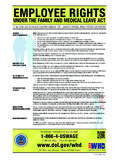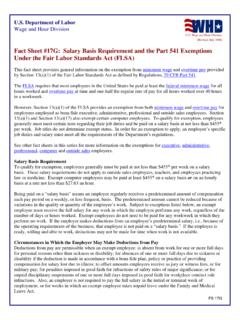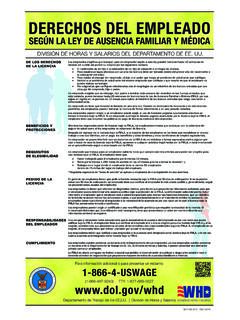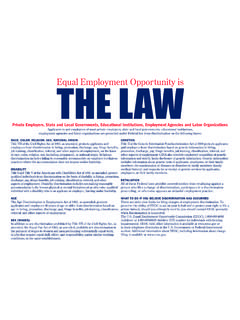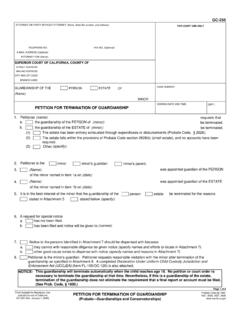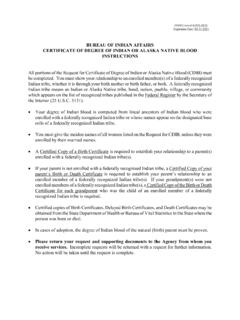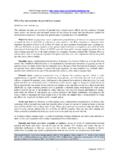Transcription of DOL POLICY BRIEF
1 DOL POLICY BRIEFP aternity LeaveWhy Parental Leave For Fathers Is So Important For Working FamiliesUNITED STATES DEPARTMENT OF LABORA lthough paid leave is often framed as an issue that matters to working women, paid parental leave is also critically important for fathers. Policies that ensure fathers have the support they need to prioritize their family responsibilities, while also meeting work demands, can significantly increase the personal and economic well-being of their families. Paternity leave and especially longer leaves of several weeks or months can promote parent-child bonding, improve outcomes for children, and even increase gender equity at home and at the workplace.
2 Paid parental leave for fathers, as well as for mothers, provides a real advantage to working these advantages, fathers still face economic and social barriers that keep them from taking longer paternity leaves, such as inadequate access to paid leave and outdated workplace norms about male breadwinners. Here in the United States where parental leave is already too rare, social and cultural biases along with gaps in POLICY make fathers even less able to access time away from work for their children. Paid paternity leave is less likely to be offered by employers than maternity leave, and may not always be taken even if offered.
3 For two-dad families, and the increasing number of fathers who are serving as stay at home parents, addressing this unequal access and uptake is particularly Workers often face tension in balancing their roles as workers and parents, since there can be adverse consequences to prioritizing family over work or work over family. Empowering more dads with paid parental leave means they can achieve their professional goals and be supportive, nurturing fathers and partners. This is an area where paid leave POLICY is evolving on the international stage, although even in other countries that have made much greater strides to offer robust and generous maternity leave policies, paternity leave lags behind.
4 (Fewer than half the countries in the world provide men with access to paid leave to care for a new child, while virtually all provide paid maternity ) But innovative new efforts to boost fathers use of parental leave are accelerating a cultural change and breaking down gender stereotypes about work and family. Best practices to support increased access to and use of parental leave by fathers include making leave paid, educating workers and employers about the benefits of paternity leave, and structuring leave programs to incentivize fathers taking leave and be more inclusive of all parents.
5 The combination of better economic supports and changing cultural norms can ensure all families can benefit from paternity leave. 2 million fathers were stay at home dads in fathers and their Perez: Fathers taking parental leave helps not just children but moms, too, by changing who changes the diapers and the whole culture around work and family. Nine out of ten fathers took some time off work for the birth or adoption of a parental leave for men is more limited than for women. Fathers typically take time off but take very short leaves. While survey data shows that nine out of ten fathers take some time off work for the birth or adoption of a child, seventy percent of fathers take ten days of leave or In other countries, paid paternity leave is also typically substantially shorter than paid maternity leave.
6 Some nations provide couples with shared parental leave (a period of paid and/or unpaid parental leave that the parents may divide as they choose) and under that system men tend not to utilize the shared leave as much as women or use only relatively small Access to paid paternity leave in the United States is rare. Although most workers have no access to paid parental leave at all, more employers provide paid maternity leave than paid paternity leave. A 2012 Department of Labor study found that fewer employers offer paid parental leave for men than for women, and also that fewer men report receiving paid parental leave than women.
7 (Only 13 percent of men who took parental leave received pay compared with 21 percent for women).5 Three states California, New Jersey, and Rhode Island provide paid family leave to both mothers and fathers on an equal fathers take paternity leave especially when they take longer leaves it can lead to better outcomes for theirchildren and the whole paternity leaves are associated with increased father engagement and bonding. Longer leaves mean dads have more time to bond with a new child, and will be more involved in caring for their children right from the start. This hands-on engagement can set a pattern that lasts long after the leave ends.
8 For example, in one study of working fathers in the , those who took leaves of two weeks or more were much more likely to be actively involved in their child s care nine months after birth including feeding, changing diapers, and getting up in the Studies from other countries have confirmed that fathers who take more paternity leave have higher satisfaction with parenting and increased engagement in caring for their Increased engagement leads to improved health and development outcomes for children. We also know that when fathers are more engaged with their children, their children have better developmental outcomes.
9 This includes fewer behavioral problems and improved cognitive and mental health A study of four OECD countries, including the United States, found evidence suggesting that longer paternity leaves and increased time fathers spent caring for their very young children is associated with higher cognitive test scores for their in ten fathers taking parental leave took ten days of leave or with fathers who take more leave also share chores and childcare more equally between mothers and fathers. One of the more interesting emerging new research findings is that increasing paternity leave may also change longstanding cultural norms about gender, work and household responsibilities.
10 When men increase their use of paternity leave, time studies show that the amount of household work fathers and mothers perform may become more gender balanced over time, with the men spending longer amounts of time per day on household chores and This means that increasing how much parental leave fathers take can change the culture in ways that make it more leave reduces work-family conflict for fathers. Fathers are increasingly concerned about work-life balance, and nearly half of men surveyed report that the demands of work interfere with family Paid leave makes it easier for fathers, like mothers, to better balance their responsibilities at work and at fathers take leave, it can increase employment and pay for mothers.
